More about Thimbles





Magdalena and William Isbister.
In 1964 (1) Roger Lenain purchased ‘Le Dé à Coudre’, a thimble making company that was already occupying the Lenain workshops in Paris. ‘Le Dé à Coudre’ came into being as a result of the amalgamation of Maison Lorillon and Maison A Féau, the two leading Parisian thimble-making businesses at the beginning of the 20th century. Roger Lenain of Orfèvrerie Lenain was interested in reviving the thimble making side of the company and in the 1970s, in conjunction with Mrs. Rosalind Belford of ‘Sewing Corner’ and later ‘Collectors Choice’ re-issued the de la Fontaine Fable and other commemorative thimbles (2) for the American market. In one of the Belford catalogues the thimbles are described as being made with the original dies ‘discovered in Paris after more than 70 years’.
These dies were the original Lorillon/A Féau dies purchased by Roger Lenain in 1964 when he bought ‘Le Dé à Coudre’.
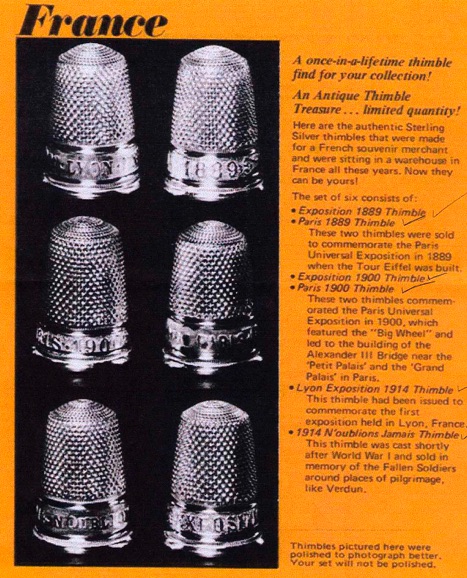
In the mid 1970s, a set of six, very blackened, silver thimbles came onto the American market. These, the so-called ‘Exposition thimbles’ again came from Mrs. Belford and were sold in 1975 through the Collectors Choice - Sewing Corner Catalogue. They were described as having been ‘’made for a French souvenir merchant and were sitting in a warehouse in France all these years’’. This is the ‘merchant’s warehouse’ fable.

The set consisted of thimbles commemorating the ‘’1889 Exposition’’, the ‘’1889 Paris Exposition’’, the ‘’1900 Paris’’ exposition, the ‘’1900 Exposition’’, the ‘’1914 Lyon Exposition’’ and the 1914 World War I thimble ‘’N’oublions jamais 1914’’ (see below).
All of these thimbles have the same marks. The word ‘France’, a size number, the makers mark of Roger Lenain - it comprised the letters ‘L’ and ‘F’ separated by two interlaced ‘L’s, one reversed - and the Mercury head export mark signifying silver of a lower silver content (800). Articles marked in this way may not be sold in France unless a further mark has been added signifying that the tax from which they were exempted has been duly collected prior to their sale in France (3). This mark – the hare’s head is not present on any of these thimbles.
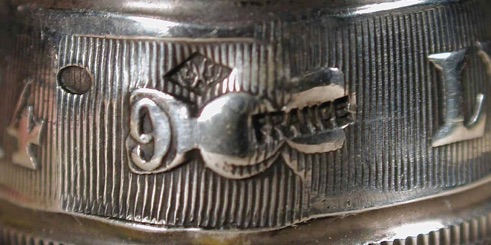
It is our belief that all of these so-called ‘Exposition thimbles’ were re-issued at the time of the re-issue of all the other Lorillon/A Féau thimbles by Roger Lenain in the 1970s. It is extremely unlikely that six commemorative thimbles, commemorating events some 25 years apart, would have been originally issued at the same time and had identical markings or that they would all have ended up in a single ‘souvenir merchant’s’ store given the different timing of their original issue. We question too why a merchant in France would keep thimbles which were not meant for the domestic market, but for export, for as long as 80 years. If it is unlikely that all the thimbles would have had the same markings given their dispersed times of issue, it is even less probable that the markings on the thimbles in question would have been exactly the same as the markings on all of the Lenain re-issues which were commissioned by Mrs. Belford unless they were commissioned around the same time.
The ‘antiquing’ of the thimbles is all too easy and so the ‘old’ appearance’ of the ‘Exposition thimbles’ may not be used as an argument to authenticate the ‘merchant’s warehouse’ fable.
Very few French, late 19th century and early 20th century thimbles that are made for the domestic market have a size number and this is further evidence against the ‘Exposition thimbles’ being from the original issues.
The marking ‘France’ is not seen on any French thimbles except the Lenain re-issues so it is virtually impossible for the mark to have appeared on a ‘set’ of commemorative thimbles, issued 25 years apart, at the turn of the last century.
The French domestic ‘Exposition thimbles’ seem to have flatter tops than the re-issues. The French domestic thimble below has the boar’s head mark and an unreadable makers’ mark.
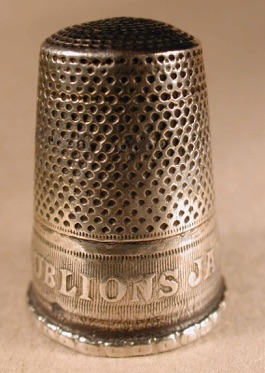
The re-issue below has four marks – Mercury head, size, ‘France’ and the R Lenain maker’s mark – a more rounded top and a plain round turnover rim.
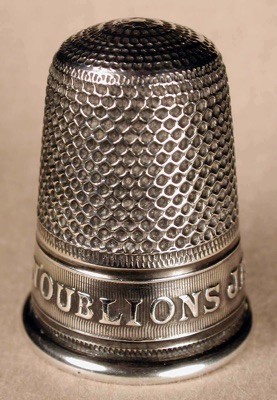
The most compelling evidence against the ‘merchant’s warehouse’ Fable, however, comes from the maker’s mark itself.
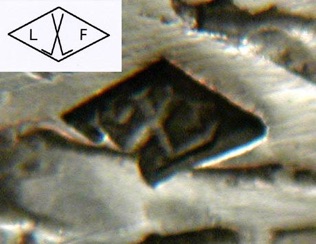
The LF separated by two interlaced ‘L’s, one reversed, was first registered in 1929 by Lenain Frères (4). In 1938 the same mark was used by Lenain et Cie. and in 1964 when Roger Lenain (Orfèvrerie Lenain) bought ‘Le Dé à Coudre’ he continued to use the same mark (Roger Lenain, personal communication).
The ‘Exposition Thimbles’ with the Lenain mark could therefore not possibly have been made and marked at the time of the event commemorated and it seems pretty unlikely that they would have been made some 30-40 years after the events that they were commemorating. Thimbles made, in France, for export in the late 19th and early 20th century are usually found with the standard of purity and the makers mark in an ‘Obus’ (cannon shell) (3), not with a Mercury head and the word ‘France’.
It is our belief that the evidence overwhelmingly supports the fact that the so-called ‘Exposition thimbles’ which were sold by Mrs. Belford were commissioned re-issues and that the ‘merchant’s warehouse’ is another ‘thimble fable’ in need of correction. That the dies were ‘discovered in Paris after more than 70 years’ is not in question.
Acknowledgements:
We are especially thankful to the people listed below who responded promptly to our many questions:
Ghislaine Chaplier who answered many, many emails and relayed information from Monsieur Roger Lenain.
Michel Painsonneau who shared his knowledge of French thimble making history with us and who managed to get information from the Chef de la Cellule Technique de Garantie de Paris (Bureau of Garantie of Paris, Bureau of Customs, Paris).
Wolf-Dieter Scholz who made his vast library of references available to us.
References:
1. Crestin-Billet F. Ouvrages de dames. Paris Tana, 2005. pp. 67-77.
2. Belfford R. French Silver Thimbles. Silver, 1979: July-August: 34.
3. Tardy International Hallmarks on Silver, 1985. 5th Edition, 2000.
4. Bureau of Garantie of Paris, Bureau of Customs, Paris.
TCI Bulletin Spring 2007
Holmes: ‘Thimbles in France’ pp. 65.
Researched and published in 2002/11
Copyright@2011. All Rights Reserved
Magdalena and William Isbister, Moosbach, Germany
the ‘merchants warehouse’ fable
Navigation
